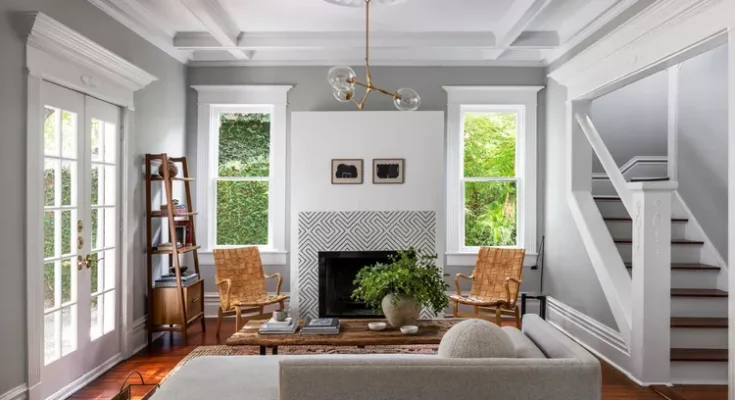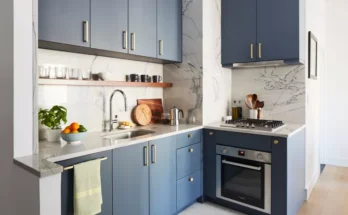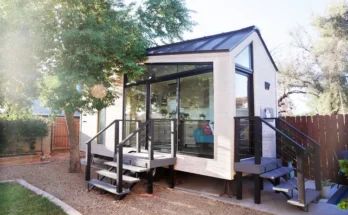Experts are sharing their best tips for elevating small spaces.
You might not be able to increase a room’s square footage, but you can use paint to visually expand the space. Paint offers a cheap and easy way to update a space, and when used strategically, it can visually extend ceiling height and make walls recede to create a more expansive feel. “Color can trick the eyes and create the illusion of a larger space,” says Hannah Yeo, senior manager of color marketing at Benjamin Moore.
We turned to paint color experts to get their best painting tricks and find out which paint colors help make rooms look bigger and which ones are best to avoid. Sure, statement ceilings are a fun design trend, but does painting the ceiling draw your eyes up or make the space look like a cave? Similarly, many people have jumped on the color drenching bandwagon, but does the color trend only enclose a space and make it look smaller? Read on for our experts’ best painting tips, tricks, and techniques to make a room look larger.
1. Stick with Soft Neutrals
As a general rule of thumb, stick with soft neutrals if you want to make a room look larger. “Opt for soft, light, and neutral tones for the walls, while incorporating bolder hues in your accessories,” Yeo says. These tones reflect light instead of absorbing it to create a more expansive feel and their gentle appearance has a calming, breathable effect. “Whether through a painted chair or a colorful throw pillow, adding a few bright accents draws attention to the foreground, making the walls fade into the background,” she adds.
2. Paint Trim in Rooms with Low Ceilings
“For rooms with low ceilings, paint the trim the same color as the walls to help the space feel taller by blending the trim in,” Yeo suggests. In small spaces, there is power in continuity and using contrasting colors on walls and trim can create a choppy look and disrupt continuity. Extending the wall color to the trim creates a seamless transition and make a room with low ceilings appear larger.
3. Stay Away from Sharp Color Contrasts
If you’re trying to create the illusion of a larger space, in addition to avoiding paint colors that absorb light, Erika Woelfel, BEHR’s VP of color and creative services, advises against sharp color contrasts because they can make the room feel more enclosed. “Overly bold patterns or high-contrast combinations between walls and ceilings can also disrupt the flow of the room, making it feel smaller,” she says. Instead, Woelfel suggests you focus on maintaining a balanced and cohesive color palette that promotes openness and flow throughout the entire space.
:strip_icc():format(webp)/BHI_Cedarleaf_025-2000-1127bebf0e804c2a9e6721506793edfc.jpg)
4. Reach for Cool-Toned Colors
Paint experts say cool-toned colors tend to make walls recede and make a space feel larger. “Soft whites, light grays, pale blues, and gentle greens are all great choices as they reflect light, helping to create a fresh and spacious atmosphere,” Woelfel says. If you’re looking for a little more warmth, she suggests using a light beige or warm taupe tone, but notes that it’s important to keep the paint colors muted for a more expansive effect. “Tranquil Gray and Blank Canvas are two of my favorites for making a space feel bigger,” she says.
5. Reflect Light with Pale Yellow
If you’re working with a room that has limited natural light, Yeo suggests adding a splash of pale yellow such as Windham Cream or Crisp Linen. The sunlit hues instantly brighten a space by reflecting more light and bringing in an optimistic energy.
6. Apply the LRV Rule Based on Lighting
In the context of paint colors, LRV refers to light reflective value. Simply put, a paint color’s LVR reveals how much light it reflects. Kantz says it’s important to consider the amount of natural light in a room when choosing a paint color and applying the LRV rule based on lighting. “Higher LRV colors like Creamy or Drift of Mist can help in rooms with low natural light, whereas lower LRV colors like Storm Cloud or Pavestone will work best in rooms with a lot of natural light,” she explains.
7. Use Serene Blues on Walls or Ceilings
If you want to incorporate a soft pop of color into a room, Woelfel recommends turning to calming shades of blue such as Aerial View. “It’s a serene sky blue that evokes peaceful reflection, creating a calming ambiance while maintaining an open and airy feel in the room,” she says.
A soft blue shade on the ceiling can create the illusion of blue skies and visually raise the ceiling height. “I love our 2024 Color of the Year, Upward, as a ceiling color because it’s like a recreation of the sky,” Kantz says. This paint trick isn’t just for indoor spaces, in fact, there is a longstanding tradition of painting porch ceilings in shades of haint blue to create a sky-like effect.
:strip_icc():format(webp)/bhg-white-living-room-fireplace-windows-8R6A8763HDREdit-ef59923c29c44846be6acd0becc03492.jpg)
8. Choose White Paint
White is a go-to when choosing a paint color that reflects light, brightens a space, and makes a room look bigger. “Digging a little deeper into color theory, white and similar lighter hues are recessive to the optic nerve, creating the illusion of a larger space,” says Emily Kantz, director of color marketing at Sherwin-Williams. Not all white paint colors are alike and there is more variation in white tones than you may think. Stark whites create a clean and refreshing feel, while warm white and off-white tones introduce an element of coziness while maintaining openness.
9. Paint the Ceiling a Shade Lighter Than the Walls
“Using a lighter color above eye level can create an airy effect and visually elevate the ceiling,” Yeo says. She explains that this technique is ideal for making a room appear larger and taller, so it’s particularly effective in smaller spaces or in rooms with lower ceilings. “Simply paint the ceiling a lighter shade, or a subtle variation, of the wall color,” the color expert suggests. The slight color contrast gently adds depth and dimension without disrupting the room’s overall color scheme.
10. Use a Higher Gloss Finish
It’s not just the paint color that can make a room appear larger, the paint finish plays a role, too. While higher gloss finishes can highlight imperfections on the walls, Yeo says they can also reflect more light. The more light the paint reflects, the more spacious the room feels. “To achieve a smooth, flawless finish, be sure to take the time to properly prep and sand the surface before painting,” Yeo says.
:strip_icc():format(webp)/dining-room-wooden-table-chairs-b5f28f14-1099243a2cb543ebb860fc27905e14c2.jpg)
11. Draw the Eyes Up with a Statement Ceiling Color
Even though a light paint color can make low ceilings look taller, you can also take a completely different approach and draw the eyes up with a statement ceiling color. “A bold, dark ceiling color can create an interesting focal point in a room; When the rest of the room is painted in light, reflective tones, a statement ceiling color can visually raise the height and draw the eye upward,” Woelfel explains. The color she’s currently loving for this effect is BEHR’s 2025 Color of the Year, Rumors, which is a deep ruby red that adds rich warmth while still maintaining a sense of openness when applied on the ceiling. “It’s a dynamic, captivating tone that makes a statement and works beautifully to create a sense of depth and drama without overwhelming the room,” Woelfel says.
12. Avoid Color Drenching
Color drenching has been a big color trend in recent years, but experts say it’s not one to implement if you’re trying to make a room look bigger. “For ceilings, I would avoid painting the ceiling the same color as the surrounding walls as color drenching in mid to deeper tones sometimes creates a smaller feel,” Kantz says. Applying the same paint color to the walls, trim, ceiling, and even doors visually encloses and gives it a cozier feel, but it’s a trend to avoid if you want to make an already small space feel larger.
13. Incorporate Vertical Stripes
Vertical lines draw the eyes up and can be an excellent way to expand a space. “Consider incorporating vertical lines or light-colored stripes to add height, making the room feel taller,” Woelfel suggests. Vertical shiplap is another clever trick for visually extending ceiling height. The wall paneling introduces vertical lines in a subtle way to set an expansive backdrop for furniture and home decor.
14. Blur Wall Edges with Deep Tones
Just because a room is small, Yeo says it shouldn’t hold you back from using rich and bold colors. Even though as a general rule of thumb you want to stick with light colors to make a room appear larger, the expert says when done right, deeper tones can have the same effect. “Deep tones can blur the edges of the walls, creating the illusion of a more expansive space,” Yeo says. To prevent darker hues from overwhelming a space, she recommends balancing them out with plenty of light tones in your furniture, linens, and artwork.



